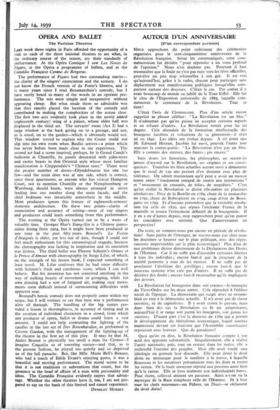OPERA AND BALLET
The Parisian Theatres Lan. week three nights in Paris afforded the opportunity of a visit to each of the three national theatres to see what, in the ordinary course of the season, are their standards of performance. At the Opera Comique I saw Les Noces de Figaro, at the Opera a programme of ballets, and at the Comedic Francaise Cyrano de Bergerac.
The performance of Figaro had two outstanding merits—
the clarity of the singers' enunciation and the scenery. I do not know the French version of da Ponte's libretto, and it is many years since I read Beaumarchais's comedy, but I have rarely heard so many of the words in an operatic per- formance. The sets were simple and inexpensive without appearing cheap. But what made them so admirable was that they exactly placed the location of the comedy and contributed to making the complexities • of the action dear. The first two acts evidently took place in the newly added (eighteenth century) wing of a palace, whose older hall was displayed in the third act. The servants' room (Act I) had a large window at the back giving on to a passage, and not, as is usual, on to the garden—which it obviously would not. This window served to explain why the Count could not slip into his own room when Basilio arrives—a point which has never before been made clear in .my experience. The second act had a scene inspired, perhaps, by le Grand Conde's bedroom at Chantilly, its panels decorated with palm-trees and exotic beasts in that Oriental style whose most familiar manifestation is Chippendale's " Chinese taste." There were the proper number of doors—Glyndebourne has one too few—and the main door was at one side, which is correct, since these apartments, as anyone who has visited Hampton Court, not to mention Chantilly or the Nymphemburg or Wurzburg, should know, were always arranged in series leading into one another along the main facade, and the chief bedroom was invariably somewhere in the middle. Most producers ignore this feature of eighteenth-century domestic architecture. On these two points—clarity of enunciation and accuracy of setting—most of our singers and producers could learn something from this performance.
The evening at the Opera turned out to be a waste of
valuable time. Georges Hue's Siang-Sin is a Chinese panto- mime dating from 1924, but it might have been produced at any time in the past fifty years. Roussel's Le Festin d'Araignie is older, yet less out of date, though I could not feel much enthusiasm for this entomological tragedy, because the choreography was lacking in inspiration and its execution was lifeless. The third ballet was Florent Schmitt's Oriane et le Prince d'Amour with choreography by Serge Lifar, of which, on the strength of his recent book, I expected something at least novel. M. Lifar confesses that he had some difficulty with Schmitt's thick and cumbrous score, which I can well believe. But his invention has not contrived anything in the way of striking beauty of movement or grouping, while his own dancing had a sort of fatigued air, making easy move- ments seem difficult instead of surmounting difficulties with apparent ease.
Rostand's heroic comedy does not properly come within my scope, but I will venture to say that here was a performance alive all through. The handling of the big scenes pro- vided a lesson in thoroughness, in accuracy of timing and in the creation of individual characters in a crowd, from which any producer of opera, ballet or drama could learn a vast amount. I could not help contrasting the lighting of the candles in the last act of Der Rosenkavalier, as performed at Covent Garden, with the management of the lighting-up of the theatre in the first act of this play. It may be that M. Andre Brunot is physically too small a man for Cyrano—I imagine Coquelin as of towering stature—and that, as is the present fashion, he played too quietly and so deprived us of the full panache. But, like Mlle. Marie Bell's Roxane, who had a touch of Edith Evans's enjoying gusto, it was a beautiful and moving performance. The moral seems to be that it is not traditions or subventions that count, but the presence at the head of affairs of a man with personality and ideas. The Comedic Francaise evidently enjoys that advan- tage. Whether the other theatres have it, too, I am not pre- pared to say on the basis of this limited and casual experience.
DYNELEY HUSSEY.










































 Previous page
Previous page